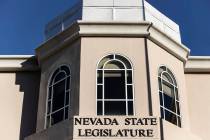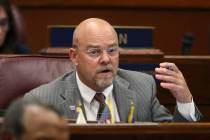Teachers union caught in legal Catch-22
Nobody was more surprised in court this week than the Nevada State Education Association when Carson City District Judge James E. Wilson struck down the union’s initiative petition to create a 2 percent margins tax on businesses.
The petition’s 200-word description of effect was “deceptive and misleading, and invalidates the petition,” Wilson ruled, because it failed to tell voters that the money raised by the tax to pay for schools might be appropriated by the Legislature to pay for something else.
“The initiative requires some of the revenue stream to be deposited into the [Distributive Schools Account],” Wilson wrote in his ruling this week. “The initiative does not prevent the Legislature from supplanting existing education funds with the margins tax. Thus, the effect is to free up funds for the Legislature to use as it wishes, for education and non-education purposes. This effect is something those being asked to sign the petition should know.”
Why the surprise? Because just two short months ago, Wilson heard the exact same arguments from the exact same attorneys and ruled they “failed to carry its burden of demonstrating that the description of effect is defective.”
Josh Hicks, attorney for the Committee to Protect Nevada Jobs, which opposed the teachers union tax plan, said Wilson acknowledged he might have made a mistake in August, and he corrected his ruling to reflect his change of heart.
But the downside is this: The teachers union re-wrote its petition in response to Wilson’s August ruling, removing portions that he found invalid but retaining language that he’d found sufficient. And since Wilson rejected the “supplanting” arguments the first time around, the union believed that portion of its petition was legally sound.
Instead, it became the flaw that could invalidate the entire petition, which has gathered an estimated 100,000 signatures.
If an appeal to the Nevada Supreme Court is unsuccessful, all the work and money the union has put into the effort will have been wasted. (A notice of appeal was filed Thursday.)
But that’s not the only reason the union must be frustrated.
Back in 2001, the union proposed a 4 percent business profits tax in an initiative that also sought to force the state to spend 50 percent of its general fund budget on education. Ultimately, the Supreme Court rejected the measure, saying that any mandate for spending had to contain a tax sufficient to cover the entire expenditure. In other words, if you want to fund schools at a minimum of, say, $3 billion for a two-year budget cycle, you have to come with a $3 billion tax. Good luck with that.
Nowadays, of course, the 2001 petition would never even get close to the Supreme Court because of something called the “single-subject rule,” which limits initiative petitions to a single subject. That means you couldn’t have an initiative that raises a tax and directs the state to spend a minimum amount on schools. It’s also why you couldn’t raise a tax and demand that money be used only for education; not only might the spending mandate be attacked, it wouldn’t solve the supplanting issue.
You could try two separate petitions, one that raises a tax and another that establishes minimum spending, but be prepared for opponents to claim that the latter is an unconstitutional unfunded mandate – and for the courts to agree.
Bottom line: It’s well-nigh impossible to raise money for schools by initiative. And since the union only turned to an initiative because the Legislature has failed to act, the teachers union has discovered a rare and previously undiscovered species of Catch-22.
Happy Nevada Day (observed).
Steve Sebelius is a Review-Journal political columnist and author of the blog SlashPolitics.com. Follow him on Twitter (@SteveSebelius) or reach him at (702) 387-5276 or ssebelius@reviewjournal.com.












